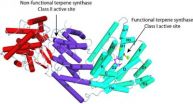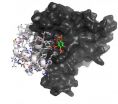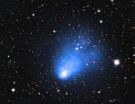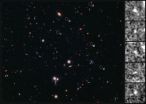(Press-News.org) The recent discovery that bisabolane, a member of the terpene class of chemical compounds used in fragrances and flavorings, holds high promise as a biosynthetic alternative to D2 diesel fuel has generated keen interest in the green energy community and the trucking industry. Now a second team of researchers with the U.S Department of Energy (DOE)'s Joint BioEnergy Institute (JBEI) has determined the three-dimensional crystal structure of a protein that is key to boosting the microbial-based production of bisabolane as an advanced biofuel.
The JBEI research team, led by bioengineers Paul Adams and Jay Keasling, solved the protein crystal structure of an enzyme in the Grand fir (Abies grandis) that synthesizes bisabolene, the immediate terpene precursor to bisabolane. The performance of this enzyme - the Abies grandis α-bisabolene synthase (AgBIS) - when engineered into microbes, has resulted in a bottleneck that hampers the conversion by the microbes of simple sugars into bisabolene.
"Our high resolution structure of AgBIS should make it possible to design changes in the enzyme that will enable microbes to make bisabolene faster," says Adams, a leading authority on x-ray crystallography. "It should also enable us to engineer out inhibition effects that slow throughput, and perhaps also engineer the enzyme to produce other kinds of fuels similar to bisabolane."
Adams, who heads JBEI's Technologies Division, is the corresponding author of a paper describing this work in the Cell Press journal Structure. The paper is titled "Structure of a Three-Domain Sesquiterpene Synthase: A Prospective Target for Advanced Biofuels Production." Co-authoring it with Adams and Keasling were Ryan McAndrew, Pamela Peralta-Yahya, Andy DeGiovanni, Jose Pereira and Masood Hadi.
JBEI is one of three DOE Bioenergy Research Centers established by DOE's Office of Science to advance the technology for the commercial production of advanced biofuels. It is a multi-institutional partnership led by the Lawrence Berkeley National Laboratory (Berkeley Lab) and headquartered in Emeryville, CA.
This past fall, JBEI researchers identified bisabolane as a potential new advanced biofuel that could replace D2 diesel, today's standard fuel for diesel engines, with a clean, green, renewable alternative that's produced in the United States. Using the tools of synthetic biology, the researchers engineered strains of bacteria and yeast to produce bisabolene from simple sugars, which was then hydrogenated into bisabolane. While showing much promise, the yields of bisabolene have to be improved for microbial-based production of bisabolane fuel to be commercially viable.
"The inefficient terpene synthase enzyme is one of the bottlenecks in the metabolic pathway used by the engineered microbes," says Peralta-Yahya, a lead member of the earlier JBEI team as well as the current team. "Knowing the AgBIS crystal structure will guide us in engineering it for improved catalytic efficiency and stability, which should bring our bisabolene yields closer to economic competitiveness."
Peralta-Yahya and her colleagues determined that the AgBIS enzyme consists of three helical domains, the first three-domain structure ever found in a synthase of sesquiterpenes - terpene compounds that contain 15 carbon atoms. The discovery of this unique structure holds importance on several fronts, as co-lead author of the Structure paper McAndrew explains.
"That we found the structure of AgBIS to be more similar to diterpene (two carbon terpene compounds) synthases not only provides us with insight into the function of these less well characterized enzymes, it also provides us with clues to the evolutionary heritage as the archetypal three-domain terpenoid synthases became two-domain sesquiterpene synthases in plants. Furthering our knowledge of the structures and functions of terpenoid synthases may prove to have abundant practical applications aside from advanced biofuels because these
enzymes produce a wide variety of specialized chemicals."
Solving the three-dimensional crystal structure of AgBIS was made possible by the protein crystallography capabilities of Berkeley Lab's Advanced Light Source (ALS), a DOE Office of Science national user facility for synchrotron radiation, and the first of the world's third generation light sources. For this work, the JBEI team used three of the five protein crystallography beamlines operated by the Berkeley Center for Structural Biology (BCSB) - beamlines 8.2.1, 8.2.2, and 5.0.3.
"We needed to use multiple beamlines because we collected data on several crystals - the protein by itself, and the protein with different inhibitors and cofactors," says Adams, who headed the BCSB from 2004 to 2011. "Also, the approach we used to solve the AgBIS structure required high flux tunable x-rays such as those provided at 8.2.1 and 8.2.2, which are superbend beamlines."
INFORMATION:
This research was supported by the DOE Office of Science.
JBEI is one of three Bioenergy Research Centers established by the DOE's Office of Science in 2007. It is a scientific partnership led by Berkeley Lab and includes the Sandia National Laboratories, the University of California campuses of Berkeley and Davis, the Carnegie Institution for Science, and the Lawrence Livermore National Laboratory. DOE's Bioenergy Research Centers support multidisciplinary, multi-institutional research teams pursuing the fundamental scientific breakthroughs needed to make production of cellulosic biofuels, or biofuels from nonfood plant fiber, cost-effective on a national scale. For more visit www.jbei.org
Lawrence Berkeley National Laboratory addresses the world's most
urgent scientific challenges by advancing sustainable energy, protecting human health, creating new materials, and revealing the origin and fate of the universe. Founded in 1931, Berkeley Lab's scientific expertise has been recognized with 13 Nobel prizes. The University of California manages Berkeley Lab for the U.S. Department of Energy's Office of Science. For more, visit www.lbl.gov.
DOE's Office of Science is the single largest supporter of basic research in the physical sciences in the Unites States, and is working to address some of the most pressing challenges of our time. For more, visit science.energy.gov.
Clearing a potential road block to bisabolane
Joint BioEnergy Institute researchers identify key enzyme structure
2012-01-11
ELSE PRESS RELEASES FROM THIS DATE:
Diabetes study shines spotlight on lifestyle interventions
2012-01-11
An Emory University study published in the January issue of Health Affairs assesses real-world lifestyle interventions to help delay or prevent the costly chronic disease that affects nearly 26 million Americans.
Researchers from Emory's Rollins School of Public Health (RSPH) systematically reviewed the published literature and analyzed 28 studies that tested adaptations of the Diabetes Prevention Program (DPP) trial in real-world settings. Published in 2002, this major clinical trial showed that structured lifestyle programs for people with prediabetes could halve the ...
Early-stage breast cancer patients lack knowledge; may not receive treatment they prefer
2012-01-11
CHICAGO (January 10, 2012) – According to the results of a new study published in the January 2012 issue of the Journal of the American College of Surgeons, many early-stage breast cancer survivors lacked knowledge about their disease and were not meaningfully involved in treatment discussions or asked their preferences regarding the approach to treatment. As a result, the study's investigators determined that there is a need for improvements in the quality of the surgical decision-making process for these patients.
The retrospective study sought to evaluate the quality ...
Unexpected discovery opens up new opportunities for targeting cancer
2012-01-11
Scientists at the University of Leicester have opened up a whole new approach to the therapeutic intervention for a family of anti-cancer drug targets, thanks to a completely new and unexpected finding.
Professor Schwabe and his colleagues, Drs Watson, Fairall and Santos, have published their research this week in leading science magazine Nature detailing a new understanding of how transcriptional repression complexes work. Their work, which is based around determining atomic resolution structures of medically important bio-molecular complexes, has been ongoing for six ...
Dramatic links found between climate change, elk, plants, and birds
2012-01-11
Climate change in the form of reduced snowfall in mountains is causing powerful and cascading shifts in mountainous plant and bird communities through the increased ability of elk to stay at high elevations over winter and consume plants, according to a groundbreaking study in Nature Climate Change.
The U.S. Geological Survey and University of Montana study not only showed that the abundance of deciduous trees and their associated songbirds in mountainous Arizona have declined over the last 22 years as snowpack has declined, but it also experimentally demonstrated that ...
El Gordo -- a 'fat' distant galaxy cluster
2012-01-11
An extremely hot, massive young galaxy cluster — the largest ever seen in the distant Universe — has been studied by an international team using ESO's Very Large Telescope (VLT) in the Atacama Desert in Chile along with NASA's Chandra X-ray Observatory and the Atacama Cosmology Telescope. The new results are being announced on 10 January 2012 at the 219th meeting of the American Astronomical Society in Austin, Texas.
The newly discovered galaxy cluster [1] has been nicknamed El Gordo — the "big" or "fat one" in Spanish. It consists of two separate galaxy subclusters colliding ...
Long Island Exchange Columnist Cognac Wellerlane Interviews Celebrities at The House of Savoia
2012-01-11
Over the holidays Long Island Exchange Columnist Cognac Wellerlane attended a holiday celebration at the House of Savoia. The event was hosted by suit and costume designer Michelle Savoia and Vanity Fair editor George Wayne. It was held on Essex Street in the lower east side of Manhattan.
The House of Savoia is known for its custom suits and men's apparel and Savoia is famous for designing costumes for Broadway shows. The event was sponsored by Van Gogh Vodka, and cocktail courtesy by Molinari. Among those who attended were a variety of celebrities, such as models, actors, ...
HCMWorks Managing Partner Named to Sourcing Interest Group (SIG) Advisory Board
2012-01-11
HCMWorks announced today the naming of Ted Weyn to the Sourcing Interests Group's Advisory Board.
Sourcing Interests Group (SIG), www.sig.org, is a membership organization comprised of sourcing and outsourcing professionals from Fortune 500 and Global 1000 companies, as well as the service providers and advisory firms that serve them. Members of all types are focused on advancing the sourcing/procurement and outsourcing industries by sharing best practices and thought leadership in a strictly-enforced non-commercial environment.
SIG is acknowledged globally for its ...
New findings by St. Michael's researchers about the way cells work
2012-01-11
New findings by St. Michael's researchers about the way cells work could lead to a test and therapy for kidney failure caused by E. coli
TORONTO, Ont., Jan. 10, 2012—Ever since the water supply in Walkerton, Ont., was contaminated by E. coli in 2000, Dr. Philip Marsden has been trying to figure out just how a toxin released by that particular strain of the bacteria causes kidney damage in children.
Now Dr. Marsden and his team based at St. Michael's Hospital and the University of Toronto, led by graduate student Tania Petruzziello-Pellegrini, together with an international ...
Hubble pinpoints furthest protocluster of galaxies ever seen
2012-01-11
Using the NASA/ESA Hubble Space Telescope, astronomers have uncovered a cluster of galaxies in the initial stages of development, making it the most distant such grouping ever observed in the early Universe.
In a sky survey made in near-infrared light Hubble has spotted five galaxies clustered together. They are so distant that their light has taken 13.1 billion years to reach us. These galaxies are among the brightest galaxies at that early stage of the Universe's history. They are also very young: we are seeing them just 600 million years after the Universe's birth ...
Irish Tenor, Ronan Tynan, to Keynote Myotronics 46th Anniversary Seminar
2012-01-11
Myotronics, Inc is pleased to announce its 46th Anniversary Seminar in Seattle, June 29-30, 2012 will feature Ronan Tynan of the Irish Tenors. Known for his passion and determination in surmounting various challenges throughout his life, Mr. Tynan is an inspiring motivational speaker, an accomplished athlete, an orthopedic sports medicine physician, and a celebrated tenor. Mr. Tynan will deliver the Keynote address, before the program of 20 leaders in the field of neuromuscular dentistry begins.
The seminar schedule is designed to allow participants to select the presentations ...
LAST 30 PRESS RELEASES:
Structure of dopamine-releasing neurons relates to the type of circuits they form for smell-processing
Reducing social isolation protects the brain in later life
Keeping the heart healthy increases longevity even after cancer
Young adults commonly mix cannabis with nicotine and tobacco
Comprehensive review illuminates tau protein's dual nature in brain health, disease, and emerging psychiatric connections
Book prepares K-12 leaders for the next public health crisis
Storms in the Southern Ocean mitigates global warming
Seals on the move: Research reveals key data for offshore development and international ecology
Sports injuries sustained during your period might be more severe
World's first successful 2 Tbit/s free-space optical communication using small optical terminals mountable on satellites and HAPS
Can intimate relationships affect your heart? New study says ‘yes’
Scalable and healable gradient textiles for multi‑scenario radiative cooling via bicomponent blow spinning
Research shows informed traders never let a good climate crisis go to waste
Intelligent XGBoost framework enhances asphalt pavement skid resistance assessment
Dual-function biomaterials for postoperative osteosarcoma: Tumor suppression and bone regeneration
New framework reveals where transport emissions concentrate in Singapore
NTP-enhanced lattice oxygen activation in Ce-Co catalysts for low-temperature soot combustion
Synergistic interface engineering in Cu-Zn-Ce catalysts for efficient CO2 hydrogenation to methanol
COVID-19 leaves a lasting mark on the human brain
Scientists use ultrasound to soften and treat cancer tumors without damaging healthy tissue
Community swimming program for Black youth boosts skills, sense of belonging, study finds
Specific depressive symptoms in midlife linked to increased dementia risk
An ‘illuminating’ design sheds light on cholesterol
Who is more likely to get long COVID?
Study showcases resilience and rapid growth of “living rocks”
Naval Research Lab diver earns Office of Naval Research 2025 Sailor of the Year
New Mayo-led study establishes practical definition for rapidly progressive dementia
Fossil fuel industry’s “climate false solutions” reinforce its power and aggravate environmental injustice
Researchers reveal bias in a widely used measure of algorithm performance
Alcohol causes cancer. A study from IOCB Prague confirms damage to DNA and shows how cells defend against it
[Press-News.org] Clearing a potential road block to bisabolaneJoint BioEnergy Institute researchers identify key enzyme structure




